Sewage pumps play a crucial role in maintaining the hygiene and cleanliness of our environment. They are essential components of our sewage system, responsible for transporting wastewater from homes and commercial establishments to treatment facilities. Without these pumps, the disposal of waste would be a significant challenge, leading to potential health hazards and environmental pollution.
The purpose of this article is to provide a comprehensive understanding of sewage pumps. It aims to educate readers about their importance, types, factors to consider when purchasing, top brands, costs, installation process, maintenance, and their environmental impact. By the end of this article, you will have a clear understanding of why choosing the right sewage pump is crucial for reliable wastewater disposal.
Our Top Sewage Pump Picks
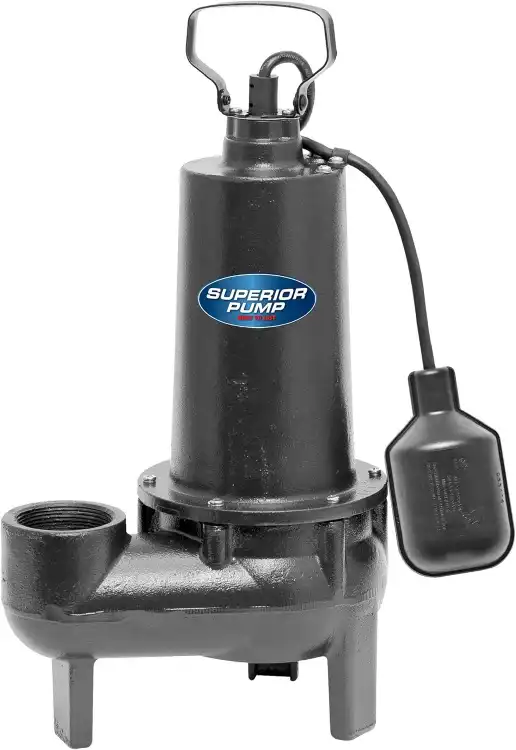
Superior Pump 93501 Cast Iron Sewage Pump
Check on AmazonKey Specs
- 1/2 HP Motor
- Maximum Flow Rate: 4,800 gallons per hour
- Maximum Lift Height: 25 feet
- 2-inch NPT Discharge
- Tethered Float Switch for automatic operation
The Superior Pump 93501 is a robust and reliable choice for managing sewage and wastewater. Its 1/2 HP motor can move up to 4,800 gallons per hour, making it suitable for both residential and commercial applications. The cast iron construction ensures durability, and the tethered float switch adds convenience by automatically turning the pump on and off. The non-clogging vortex impeller is ideal for handling solids up to 2 inches, making it versatile for various tasks. With a 25-foot lift capacity, this pump is a solid performer.
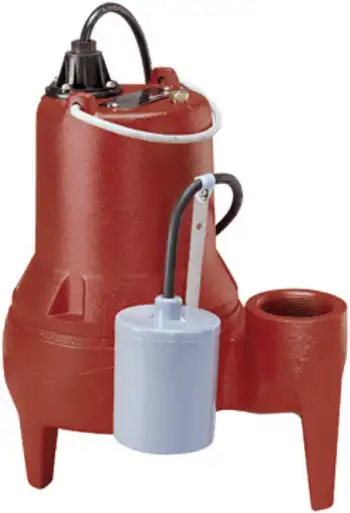
Liberty Pumps LE51A Sewage Pump
Check on AmazonKey Specs:
- Maximum Flow Rate: 160 GPM
- Maximum Lift Height: 25 feet
- 2-Inch Spherical Solid Passage
- Oil-Filled Motor with thermal protection
- Quick-Disconnect Power Cord for easy maintenance
The Liberty Pumps LE51A Sewage Pump is engineered for high performance with a 160 GPM flow rate and a 25-foot shut-off head, ensuring efficient sewage removal for residential and light commercial applications. Its oil-filled, thermally protected motor provides longevity and reliable performance, while the 2-vane semi-open impeller can pass 2-inch solids, reducing clogging. The quick-disconnect 10-foot power cord makes maintenance easy without disturbing the motor seals.
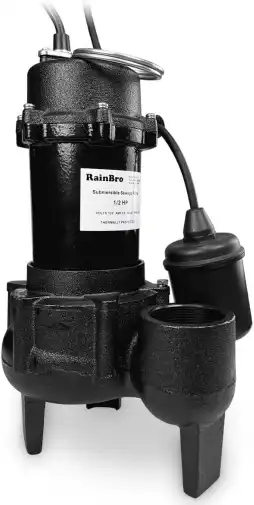
RainBro Sewage Pump
Check on AmazonKey Specs:
- Maximum Flow Rate: 83 GPM
- Maximum Lift Height: 22 feet
- Solid Handling: Up to 2 inches
- Material: Cast Iron, Silicon Carbide Mechanical Seal
- Dual Control Modes: Automatic and Manual
The RainBro Sewage Pump stands out with its 1/2 HP motor, delivering powerful performance for sewage removal. Capable of pumping up to 5,000 gallons per hour and lifting up to 22 feet, this pump is ideal for deep basement drainage and challenging sewage cleanup tasks. Featuring a dual control system (automatic and manual modes), it ensures flexibility in operation. Its cast iron housing and non-clogging impeller make it durable and reliable for handling solids up to 2 inches, while the thermal overload protector ensures safe operation.
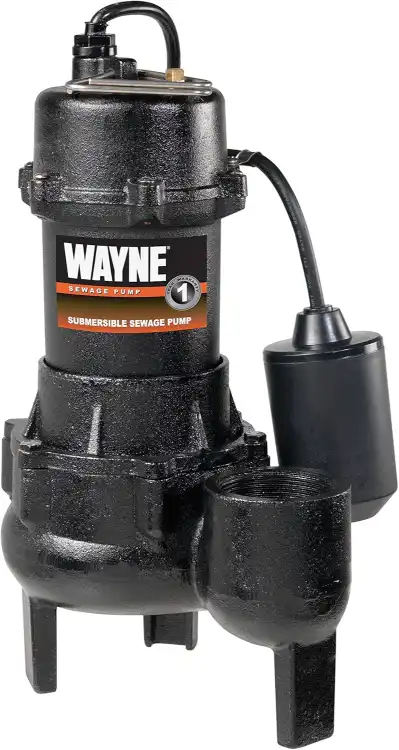
Wayne RPP50 Cast Iron Sewage Pump
Check on AmazonKey Specs:
- Maximum Flow Rate: 103.33 GPM (6,200 GPH)
- Maximum Lift Height: 10 feet
- Solid Handling: Up to 2 inches
- Material: Cast Iron
- Discharge Size: 2-inch NPT
The Wayne RPP50 Cast Iron Sewage Pump offers exceptional performance with a 1/2 HP motor, delivering up to 6,200 gallons per hour and lifting up to 10 feet of discharge. This durable, cast iron submersible pump is perfect for basement or below-grade installations, with a bottom suction design that allows it to handle solids up to 2 inches in size. Its 2-inch NPT discharge ensures reliable and efficient sewage handling in demanding conditions.
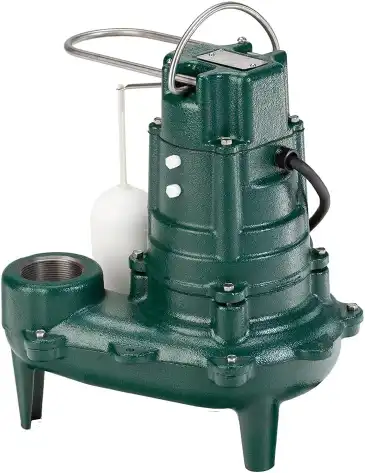
Zoeller Waste-Mate 267-0001 Sewage Pump
Check on AmazonKey Specs:
- Maximum Flow Rate: 125 GPM
- Maximum Lift Height: 21.5 feet
- Solid Handling: Up to 2 inches
- Material: ASTM Class 25 Cast Iron
- Motor Power: 1/2 HP
The Zoeller Waste-Mate 267-0001 Sewage Pump is a heavy-duty, submersible sewage pump designed for both residential and commercial use. With its 1/2 HP motor, it efficiently handles up to 125 gallons per minute and can lift waste up to 21.5 feet. Made with ASTM Class 25 cast iron, this pump ensures durability and long-lasting performance. Its non-clogging vortex impeller and automatic float-operated switch make it ideal for passing 2-inch spherical solids, providing smooth, reliable operation.
Understanding Sewage Pumps
A sewage pump, also known as a sump pump, is a machine designed to pump sewage or blackwater from a building to a septic tank or a sewage treatment facility. It is typically installed at the lowest point of the sewage basin. The pump’s primary function is to prevent the basement from flooding and to ensure that waste is disposed of properly.
Sewage pumps are indispensable in wastewater disposal. They help maintain a clean and healthy environment by efficiently transporting waste from residential and commercial buildings to treatment facilities. Without these pumps, waste would accumulate in buildings, leading to foul smells, potential health hazards, and environmental pollution.
It’s worth noting that sewage pumps are not just beneficial for health and sanitation, but they also contribute to water conservation. By transporting wastewater to treatment facilities, they enable the recycling of water, which can then be used for various non-potable purposes.
Types of Sewage Pumps
There are several types of sewage pumps, each designed for specific applications. The most common types include submersible sewage pumps, effluent pumps, and grinder pumps.
Submersible sewage pumps are designed to operate while submerged in the liquid being pumped. They are typically used in residential and commercial buildings where the plumbing system is below the level of the municipal sewer line. These pumps are known for their efficiency and durability.
Effluent pumps, on the other hand, are used to pump greywater, which is wastewater from showers, sinks, and washing machines. They are typically used in septic tank systems where the effluent needs to be pumped to a drain field.
Grinder pumps are a type of submersible sewage pump equipped with a grinding mechanism. They grind the sewage into a fine slurry, which is then pumped into a small-diameter pressure pipe. Grinder pumps are typically used in situations where the sewage needs to be pumped over a long distance or uphill.
When comparing these types of pumps, it’s important to consider their specific applications. Submersible pumps are ideal for pumping sewage in situations where the plumbing system is below the sewer line. Effluent pumps are best for pumping greywater in septic tank systems, while grinder pumps are suitable for pumping sewage over long distances or uphill.
Factors to Consider When Buying a Sewage Pump
When buying a sewage pump, several factors need to be considered to ensure you choose the right one for your needs. These factors include the size of the property and volume of wastewater, pump material and durability, power and energy efficiency, pumping capacity and head pressure, and installation and maintenance requirements.
The size of your property and the volume of wastewater it produces are crucial factors to consider. A larger property or one that produces a large volume of wastewater will require a more powerful pump. The pump material and durability are also important. Pumps made from durable materials like cast iron or stainless steel are likely to last longer and require less maintenance.
Power and energy efficiency are other important factors. A more powerful pump will be able to pump wastewater more quickly, but it will also consume more energy. Therefore, it’s important to find a balance between power and energy efficiency. Pumping capacity and head pressure are also crucial. The pumping capacity refers to the amount of water the pump can move per unit of time, while the head pressure refers to the height to which the pump can raise the water.
Finally, consider the installation and maintenance requirements. Some pumps are easier to install and maintain than others. It’s also worth considering whether the pump comes with a warranty, as this can provide peace of mind in case of any issues.
Top Sewage Pump Brands
There are many brands of sewage pumps on the market, each with its own strengths and weaknesses. Some of the top brands include Zoeller, Liberty Pumps, and Wayne.
Zoeller is a well-known brand in the sewage pump industry. They are known for their high-quality pumps that are durable and reliable. Zoeller pumps are made from cast iron and stainless steel, ensuring they can withstand harsh conditions.
Liberty Pumps is another top brand. They offer a wide range of pumps, including submersible sewage pumps, effluent pumps, and grinder pumps. Liberty Pumps are known for their high performance and energy efficiency.
Wayne is a popular brand known for its affordable yet high-quality pumps. They offer a variety of pumps, including submersible sewage pumps and effluent pumps. Wayne pumps are durable and easy to install, making them a popular choice among homeowners.
When comparing these brands, it’s important to consider their features and benefits. Zoeller pumps are known for their durability and reliability, Liberty Pumps for their performance and energy efficiency, and Wayne for their affordability and ease of installation.
Cost of Sewage Pumps
The cost of sewage pumps can vary widely depending on the type of pump, the brand, and the specific features. On average, you can expect to pay between $200 and $600 for a sewage pump. However, high-end models can cost over $1,000.
Several factors can affect the cost of a sewage pump. These include the type of pump (submersible, effluent, or grinder), the brand, the material the pump is made from, the power of the pump, and any additional features like a built-in grinder or automatic switch.
In addition to the cost of the pump itself, you should also consider the cost of installation and maintenance. Installation costs can vary depending on the complexity of the installation, but on average, you can expect to pay between $500 and $1,000. Maintenance costs can also add up over time, especially if the pump requires regular servicing or repairs.
Installation Process of Sewage Pumps
The installation process of a sewage pump can be complex and should ideally be carried out by a professional. However, if you’re confident in your DIY skills, you can install the pump yourself. Here’s a basic step-by-step guide to installing a sewage pump.
First, you’ll need to dig a hole for the sewage basin. The hole should be deep enough to accommodate the basin and the pump. Once the hole is dug, place the basin in the hole and connect the inlet pipe. The inlet pipe should be sloped downwards towards the basin to allow wastewater to flow into the basin.
Next, place the pump in the basin and connect it to the discharge pipe. The discharge pipe should be sloped upwards away from the basin to allow the wastewater to be pumped out. Finally, connect the pump to the power supply and test it to make sure it’s working properly.
During the installation process, it’s important to take safety measures. Always wear protective clothing and gloves, and make sure the power supply is turned off before you start working. If you’re not confident in your ability to install the pump safely and correctly, it’s best to hire a professional.
Maintenance and Troubleshooting of Sewage Pumps
Regular maintenance is crucial to ensure the longevity and efficiency of your sewage pump. This includes checking the pump regularly for any signs of wear or damage, cleaning the pump and the basin, and replacing any worn-out parts.
Some common issues with sewage pumps include the pump not turning on, the pump running but not pumping, and the pump making unusual noises. If the pump is not turning on, it could be due to a power issue or a problem with the float switch. If the pump is running but not pumping, it could be due to a blockage in the pump or the discharge pipe. If the pump is making unusual noises, it could be due to a problem with the motor or the impeller.
If you encounter any of these issues, the first step is to troubleshoot the problem. This could involve checking the power supply, inspecting the pump for blockages, or checking the motor and impeller for signs of damage. If you’re unable to identify or fix the problem, it’s best to call a professional.
Environmental Impact of Sewage Pumps
Sewage pumps play a significant role in environmental conservation. By transporting wastewater to treatment facilities, they prevent the pollution of our water bodies and soil. The treated water can then be reused for non-potable purposes, contributing to water conservation.
However, sewage pumps can also pose potential environmental risks if not properly managed. For instance, if a pump fails or leaks, it can lead to the contamination of the surrounding environment. It’s therefore crucial to regularly maintain and inspect your pump to prevent any potential leaks or failures.
Moreover, sewage pumps consume energy, contributing to carbon emissions. Therefore, choosing an energy-efficient pump can help reduce your carbon footprint. Some pumps are also made from materials that are not environmentally friendly. Therefore, choosing a pump made from sustainable materials can further reduce your environmental impact.
Conclusion
In conclusion, sewage pumps play a crucial role in wastewater disposal. They help maintain a clean and healthy environment by efficiently transporting waste from residential and commercial buildings to treatment facilities. Choosing the right sewage pump is therefore crucial for reliable wastewater disposal.
When choosing a sewage pump, several factors need to be considered, including the size of the property and volume of wastewater, pump material and durability, power and energy efficiency, pumping capacity and head pressure, and installation and maintenance requirements. It’s also important to consider the environmental impact of the pump and to choose a pump that is energy-efficient and made from sustainable materials.
By understanding the importance of sewage pumps and how to choose the right one, you can ensure that your wastewater is disposed of efficiently and responsibly, contributing to a cleaner and healthier environment.
FAQ
What is a sewage pump?
A sewage pump, also known as a sump pump, is a machine designed to pump sewage or blackwater from a building to a septic tank or a sewage treatment facility.
What are the different types of sewage pumps?
The most common types of sewage pumps include submersible sewage pumps, effluent pumps, and grinder pumps.
How much does a sewage pump cost?
The cost of sewage pumps can vary widely depending on the type of pump, the brand, and the specific features. On average, you can expect to pay between $200 and $600 for a sewage pump.
How do I install a sewage pump?
The installation process of a sewage pump can be complex and should ideally be carried out by a professional. However, if you’re confident in your DIY skills, you can install the pump yourself.
How do I maintain a sewage pump?
Regular maintenance is crucial to ensure the longevity and efficiency of your sewage pump. This includes checking the pump regularly for any signs of wear or damage, cleaning the pump and the basin, and replacing any worn-out parts.
